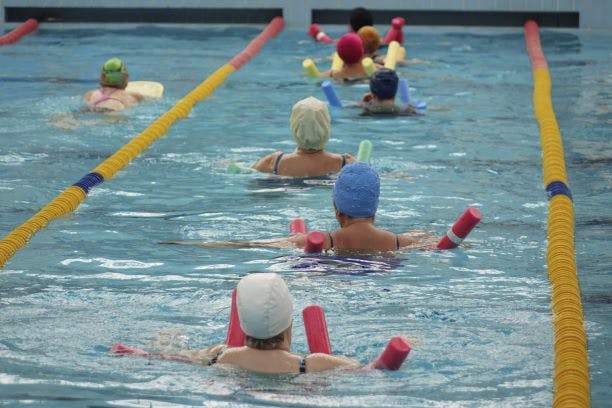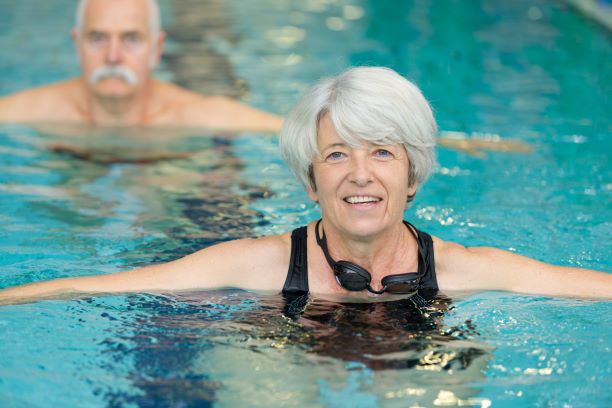Arthritis leads to more trouble walking and climbing stairs than any other muscle, joint, or bone problem. Treatment cannot “cure” arthritis. However, many treatments can slow the progression, reduce pain, and improve your quality of life. Exercise is one of the most researched and proven treatments for people suffering from arthritis pain. But what type of exercise is best for you? This article focuses on the benefits of aquatic, or pool, exercise.
Yes, exercise is medicine for people with arthritis. Regular exercise increases your muscle strength, improves your balance, and makes you more mobile. Increased muscle strength in people with arthritis is correlated with improved ability to walk and climb stairs. Improved balance is correlated with reduced fall risk and greater confidence in leaving your home. All these benefits can occur by exercising in a pool.
But It Hurts to Exercise with Arthritis
Aquatic exercise may be the best option for some people with painful arthritis. It is best to seek out heated pools, typically 82 to 88 degrees. Warm water reduces joint pain and stiffness while exercising. It also leads to greater muscle relaxation. Aquatic exercise may therefore be more beneficial as an initial form of exercise for people with painful arthritis.

Exercising in water is a gentle way to exercise your painful joints and muscles. The buoyancy of the water supports and lessens stress on your joints. This encourages freer movement. Water also acts as resistance to help build muscle strength. So exercising in warm water reduces your pain, allows easier movement, and builds your muscle strength. And don’t forget, exercising in the water with friends can be very enjoyable.
Aquatic Exercise: A Proven Treatment for Arthritis
A review of 13 clinical trials including more than 1,000 people with hip and knee arthritis showed significant benefits to exercising in water. Aquatic exercise was proven to reduce pain and improve both disability and quality of life in people with arthritis. However, there is one caveat to these findings. Improvements are greatest in the short term or for about 12 weeks. After the initial benefits have occurred with aquatic exercise, it is recommended that you also start to incorporate land exercises.
Walking in Water vs. Land
Walking in water burns more calories than walking on land. This leads to greater weight loss. This is because the resistance of the water requires extra effort to move your body.
Compared to walking on land, joint forces are reduced by 36–55% when exercising in water. Some forces during weight-bearing exercises are reduced by more than your body weight when performed in water. This creates an ideal environment to improve your strength, endurance, and walking ability without loading painful joints.
Guidelines for Starting Aquatic Exercise
You will feel really good moving in the warm water. However, it’s possible to over-exercise, become fatigued, and aggravate your joint pain. You may not realize this until you get out of the water. Therefore, you should start slow. The Arthritis Foundation has put out guidelines for exercising in water. Follow these and you will minimize the risk of any painful flare-ups.
- Start slowly and don’t overdo it.
- Submerge your body part being exercised.
- Move your body part slowly and gently.
- Begin and end with some really easy exercises.
- Move through your complete range of motion, but do not force movement. Stop if you experience any sudden or increased pain.
- Do about 8 repetitions of each exercise as tolerated. You can do 2 to 3 sets of each exercise.
- Pain that lasts for more than 2 to 3 hours after exercise may indicate overuse. Cut back next time.
- Exercising in excessively warm water (more than 98 degrees) can lead to weakness and exhaustion.
- If you have severe joint damage or a recent joint replacement you should check with your doctor before starting.
Here are a few more important considerations:
- Water shoes will help you with traction on the pool floor.
- The water level can be waist or chest-high.
- Use a Styrofoam noodle or floatation device to keep you afloat in deeper water.
- Slower movements in the water provide less resistance than faster movements.
- You can use webbed water gloves, Styrofoam weights, inflated balls, or kickboards for increased resistance.
- You will not notice that you sweat with pool exercises, but it is still very important to drink plenty of water.
Want More Help Getting Started
If you are ready to get started, try some or all of these 10 exercises in the pool. Also, the Arthritis Foundation sponsors pool exercise classes. These are great for people looking for some help at first.
Or, you may be looking for a more individualized program. Your physical therapist will examine to help you identify your weak points. Then, you and your physical therapist can design the best pool exercises specific to your needs. Give us a call if you would like help getting started.


